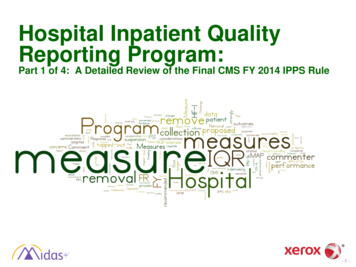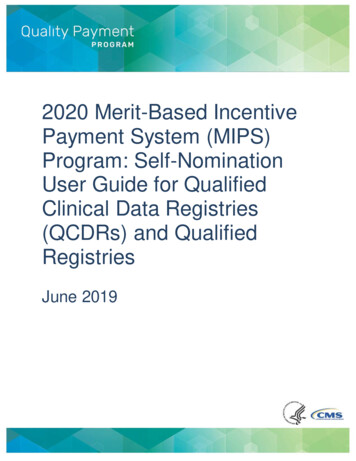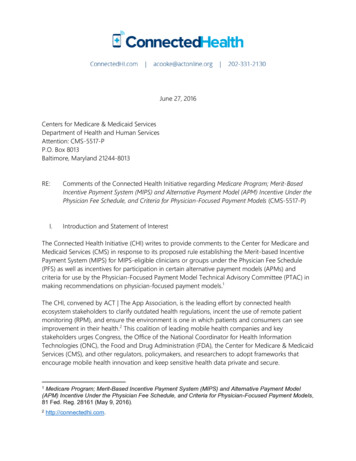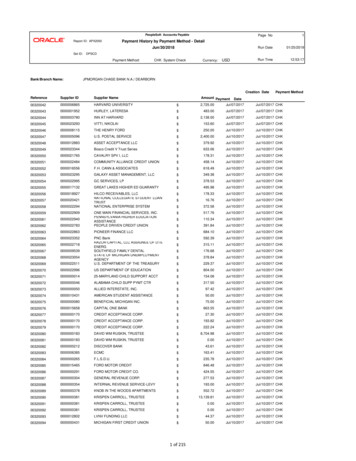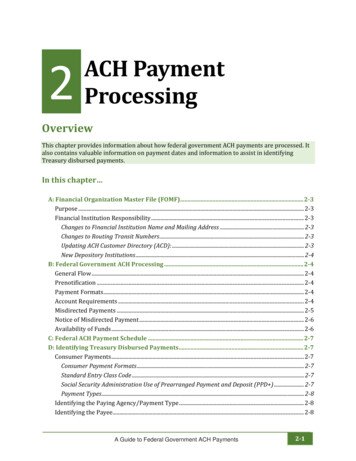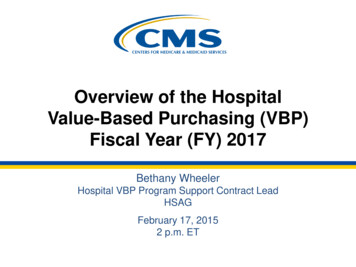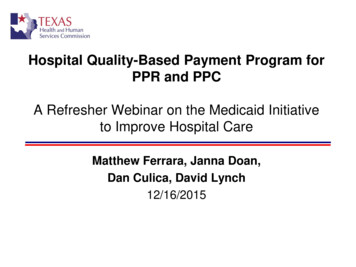
Transcription
Hospital Quality-Based Payment Program forPPR and PPCA Refresher Webinar on the Medicaid Initiativeto Improve Hospital CareMatthew Ferrara, Janna Doan,Dan Culica, David Lynch12/16/2015
Topics Covered in this PresentationI.II.Background and RationalePotentially Preventable Readmissions (PPRs) Goals, Methodology and process Common questionsIII. Potentially Preventable Complications (PPCs) Goals, Methodology and process Common questions Update on POA issueIV. ReportsI.DistributionII. FormatV. New incentive programVI. ResourcesVII. Questions from attendees2
I. Background/Rationale Part of HHSC’s and overall healthcare movement toward“Pay for Quality” Includes:–––––This programHHSC-MCO Pay for QualityMCO-Provider value based payment modelsDelivery System Reform Incentive Payment (DSRIP) programSimilar programs in Medicare, commercial insurance PPR and PPC program was legislatively directed– Used in Quality based payment program for PPR/PPC– Used in DSRIP– Used by DSHS PPRs and PPCs are viewed as within hospitals control3
I. Background/Rationale: General ProcessSpring: Inpatientclaims andencounter datacollected, preparedand analyzed forselected periodSeptember 1:ReimbursementReductions based onPPR and PPCimplemented based onhigh actual to expectedratios (FFS and MCO)HHSC TechnicalAssistance andCustomer Serviceto hospitalsthroughout yearOngoing: Hospitals identifyand implement qualityimprovement based onreports and categories ofPPR and PPCSpring: Assess Actual toExpected rates for eachhospital for each metricHospital-specific reportscreated and distributedSpring-Summer: HospitalReview data and Shareresults internally4
II. Potentially Preventable Readmissions What are Potentially Preventable Readmissions (PPRs)?PPRs are return hospitalizations that may result from deficiencies in care ortreatment provided during a previous hospital stay. PPRs can also result frominadequate post-hospital discharge follow-up. They do not include unrelatedevents that occur post discharge. Readmissions may result from actions takenor omitted during the initial hospital stay, such as incomplete treatment or poorcare of the underlying problem. In addition, a readmission may reflect poorcoordination of services at the time of discharge and afterwards such asincomplete discharge planning, and/or inadequate access to care afterdischarge. Why does Texas care about PPRs? Quality Cost High Quality Low Cost Value5
II. Potentially Preventable Readmissions(cont.) Methodology Data Used Software Actual and expected rates, A/E ratiosWhat kinds of questions do we get from hospitals? Isn't this metric used elsewhere by HHSC? Are some hospitals adversely impacted due to their patient mix (i.e. riskadjustment)? Why does HHSC use a 15 data readmission window? Is reducing PPRs really an MCO responsibility? Why is older data used to assess financial penalties for future period? Why are there no incentives? Numerous administrative type questions Discharge code questions- e.g. psych hospitals6
III. Potentially Preventable Complications What are Potentially Preventable Complication (PPCs)?A PPC is a harmful event or negative outcome with respect to a person,including an infection or surgical complication, that: (A) occurs after theperson's admission to a hospital or long-term care facility; and (B) may haveresulted from the care, lack of care, or treatment provided during the hospital orlong-term care facility stay rather than from a natural progression of anunderlying disease. Why does Texas care about PPCs? Quality Cost High Quality Low Cost Value7
III. Potentially Preventable Complications(cont.) Methodology Data UsedSoftwareActual and expected rates, A/E ratiosPresent on Admission (POA)What kinds of questions do we get from hospitals? Isn't this metric used elsewhere by HHSC?How are the POA data thresholds developed?How are these POA data validated?Are some hospitals adversely impacted due to their patient mix (i.e. riskadjustment?Why is older data used to assess financial penalties for future period?Why are there no incentives?Numerous administrative type questions8
III. PPCs and Present on Admission (POA) POA is pivotal in measuring PPC rates and ratios Under-coding, over-coding, missing POA 3M quality check Recent POA issue9
III. POA Quality ChecksQuality Screen 1: High % Non POA for secondary diagnoses on the Pre-Existing ListThis criterion identifies hospitals with a high percent non-POA (POA N) for pre-existing secondarydiagnosis codes.Red Zone: % Non POA on Pre-Exist 7.5%Grey Zone: 5% % Non POA on Pre-Exist 7.5%Quality Screen 2: High % POA for secondary diagnosesThis criterion identifies hospitals with an extremely high percent present on admission (POA Y) forsecondary diagnosis codes (excluding exempt, pre-existing, and OB 7600x-7799x codes).Red Zone: % POA 96%Grey Zone: 93% % POA 96%Quality Screen 3: Low % POA for secondary diagnosesThis criterion identifies hospitals with an extremely low percent present on admission for secondarydiagnoses codes (excluding exempt, pre-existing, and OB 7600x-7799x codes).Red Zone: % POA 70%Grey Zone: 70% % POA 77%Quality Screen 4: High % POA for secondary diagnoses on the Elective Surgical ListThis criterion identifies hospitals with a high percent non-POA (POA N) for elective surgerysecondary diagnosis codes.Red Zone: % POA 40%Grey Zone: 30% % POA 40%10
III. Update on recent POA data issue andcorrection Web-link to communication on this:http://www.hhsc.state.tx.us/hhsc projects/ECI/docs/POAinformation-FY14-082115.pdf One rural MCO transmitted erroneous POA data to HHSC (FY14 dataperiod-FY16 adjustment period).HHSC determined that the issue was significant enough to warrant reanalysisError was corrected, data was re-run: This impacted reimbursementadjustments for 31 hospitals.HHSC is in process of notifying hospitals and is sharing the list of impactedhospitals with Accenture (fee for service claims administrator) and MCOs: Fee for service claims for impacted hospitals will be re-processed back to 9/1/15MCOs provided with the same list as AccentureBecause many hospital’s A/E have changed as a result of this re-run, hospitalswill receive a new PPC report11
IV. PPR and PPC-Hospital Level Reports Reports and supplemental information are designed tohelp hospitals: understand the process efficiently assess their own performance relative to statewideaverages identify the categories of PPR/PPC so that they can targetstrategies to most effectively move their rates and impact theiractual to expected ratios. Technical Notes: Accompany Reports and help providea guide for information in reportsOther 3M information12
IV. Hospital Level Report Elements-PPR13
IV. Hospital Level Report Elements-PPR14
IV. Hospital Level Report Elements-PPR15
IV. Hospital Level Report Elements-PPC16
IV. Hospital Level Report Elements-PPC17
IV. Hospital Level Report Elements-PPC18
IV. Hospital Level Reports and Underlying DataHow do I use the information in the hospital level report asa guide for improvement?How does the underlying data relate to the hospital levelreports?19
IV. Reports PPE Confidential Hospital Level Report and Underlying Reports forFY2015 data period will be available by June 1 Hospital providers can view their individual PPE Hospital LevelReports when they log into their accounts on the secure TMHPprovider portal. The secure provider portal has a tab called Potentially PreventableEvents (PPE) Provider Reports, within this tab are two separate tabsfor PPR and PPC, where each corresponding report will be availablefor download. Underlying data can be requested via e-mail below. For questions on accessing reports, please contact:MCD PPR PPC@hhsc.state.tx.us20
V. NEW for FY16-Incentives for Safety-Net Hospitals Metrics include Potentially Preventable Readmissions (PPR) and PotentiallyPreventable Complications (PPC). Limited pool of funds 15,000,000/annual, limited pool of hospitals-this created theneed for a process to ensure that HHSC works within available funds, ensuresfairness, and is appropriately scaled.Steps: Split pool in half-50% for PPR incentives, 50% for PPC incentives Establish criteria for eligibility for each pool– non rural, non state-owned, DSH eligible– high volume– performance better at lest 10% better than state average, and no penalty forPPR or PPC Allocate a base incentive amount for each eligible hospital ( 100K) After base allocation, calculate a variable allocation based on relativeperformance and relative size (among eligible group of hospitals)21
V. Safety-Net Hospitals Incentive-Steps (cont.) Relative Performance: based on hospital’s actual to excepted ratios compared togroup averageRelative Size*: based on hospital’s inpatient claims paid compared to groupaveragePerformance-Size Composite: hospital’s relative performance score X relativesize score final relative scoreTotal Allocation for each eligible hospital for each metric:Hospital’s final relative score / total sum of relative scores for all eligible hospitals Xfunds pool after distribution of base allocations for eligible group Hospital’s Variable Allocation Hospital’s Base allocation Hospital’s Total Allocation* Note size is capped to ensure are spread more evenly among eligible hospitals22
VI. Resources Quality Website (potentially preventable events page):Contains 3M Documents, 3M portal, Technical Notes, Reports,Comparative Data on Hospitalshttp://www.hhsc.state.tx.us/hhsc projects/ECI/Potentially-PreventableEvents.shtml Resources to help reduce PPRs and PPCs: Health Care Leader Action Guide to Reduce de-to-reduce-readmissions.shtml Twelve Strategies to Reduce Error and Complication Rateshttp://www.cna.com/vcm TwelveStrategies.pdf23
VII. Questions?Questions about PPRs and PPCs?Email:MCD PPR PPC@hhsc.state.tx.us24
provider portal. The secure provider portal has a tab called Potentially Preventable Events (PPE) Provider Reports, within this tab are two separate tabs for PPR and PPC, where each corresponding report will be available for download. Underlying data can be requested via e-mail bel
